154 scholarly books by Diaphanes and 9
start with C
154 scholarly books by Diaphanes and 9
154 scholarly books by Diaphanes
9 start with C start with C
9 start with C start with C

Come On, Men, One More Effort …
Anthropogenesis, Christianity, Sexuation
Thierry De Duve
Diaphanes, 2024
A theoretical exploration of possible ways out of concepts adopted by the Enlightenment.
Thierry de Duve outlines the main features of a critical theory of male, all-too-male sexuation and cross-gender emancipation, drawing on Marcel Gauchet’s theses on Christianity as an exit from religion, Jacques Lacan’s algebra of desire, and Geneviève Morel’s analysis of the “law of the mother.”
Wouldn’t it have required more than the translation of the three Christian maxims “faith, hope, love” into the revolutionary maxims “liberté, egalité, fraternité?” Is there more to the knot of incarnation, fatherhood, and the cult of Mary than just Christian mysticism? Can the uncertainty of fatherhood become an act of faith that acknowledges a fundamental uncertainty?
Come On, Men, One More Effort… explores ways out of the dead end of political concepts adopted by the Enlightenment and their continued impact today, since the only possibility seems to be to embrace the religious and reject it at the same time.
Thierry de Duve outlines the main features of a critical theory of male, all-too-male sexuation and cross-gender emancipation, drawing on Marcel Gauchet’s theses on Christianity as an exit from religion, Jacques Lacan’s algebra of desire, and Geneviève Morel’s analysis of the “law of the mother.”
Wouldn’t it have required more than the translation of the three Christian maxims “faith, hope, love” into the revolutionary maxims “liberté, egalité, fraternité?” Is there more to the knot of incarnation, fatherhood, and the cult of Mary than just Christian mysticism? Can the uncertainty of fatherhood become an act of faith that acknowledges a fundamental uncertainty?
Come On, Men, One More Effort… explores ways out of the dead end of political concepts adopted by the Enlightenment and their continued impact today, since the only possibility seems to be to embrace the religious and reject it at the same time.
[more]
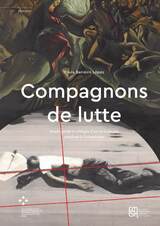
Compagnons de lutte
Avant-garde et critique d’art en Espagne pendant le franquisme
Paula Barreiro López
Diaphanes, 2023
A French-language edition of a book focused on avant-garde art and art criticism in Spain during Francoism.
[more]
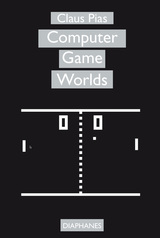
Computer Game Worlds
Claus Pias
Diaphanes, 2017
Computer games have become ubiquitous in today’s society. Many scholars have speculated on the reasons for their massive success. Yet we haven’t considered the most basic questions: Why do computer games exist? What specific circumstances led to the creation of this entirely new type of game? What sorts of knowledge facilitated the requisite technological and institutional transformations?
With Computer Game Worlds, Claus Pias sets out to answer these questions. Tracing computer games from their earliest forms to the unstoppable commercial and cultural phenomena they have become today, Pias then provides a careful epistemological reconstruction of the process of playing games, both at computers and by computers themselves. The book makes a valuable theoretical contribution to the ongoing discussion about computer games.
With Computer Game Worlds, Claus Pias sets out to answer these questions. Tracing computer games from their earliest forms to the unstoppable commercial and cultural phenomena they have become today, Pias then provides a careful epistemological reconstruction of the process of playing games, both at computers and by computers themselves. The book makes a valuable theoretical contribution to the ongoing discussion about computer games.
[more]
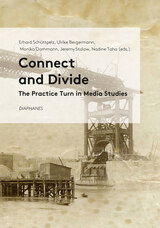
Connect and Divide
The Practice Turn in Media Studies
Edited by Erhard Schüttpelz, Ulrike Bergermann, Monika Dommann, Jeremy Stolow, and Nadine Taha
Diaphanes, 2018
Media is a kind of gatekeeper, connecting disparate entities and shielding them from one another at the same time. When we speak of media, we often refer to those entities themselves—to persons, organizations, artifacts, signals, and inscriptions—referencing directors, artists, newspapers, films, iPhones, paper, ink, notes, beats, color, and soundwaves. But as the middle or between, the essence of media itself seems to be distributed across the mix of entities involved, and its location and agency are hard to pin down.
This new anthology takes stock of our empirical and historical understanding of the two-sided nature of media and tracks the recent turn in media studies to examining practice itself. A unique discussion of the intersection of media theory and practice theory, Connect and Divide explores how distributions of knowledge, labor, and power may be hidden in what remains untraceable about media, shedding vital light on the social implications of media theory today.
This new anthology takes stock of our empirical and historical understanding of the two-sided nature of media and tracks the recent turn in media studies to examining practice itself. A unique discussion of the intersection of media theory and practice theory, Connect and Divide explores how distributions of knowledge, labor, and power may be hidden in what remains untraceable about media, shedding vital light on the social implications of media theory today.
[more]
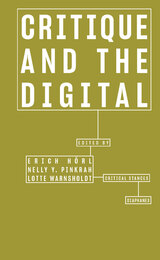
Critique and the Digital
Edited by Erich Hörl, Nelly Y. Pinkrah, and Lotte Warnsholdt
Diaphanes, 2020
Erich Hörl, Nelly Y. Pinkrah, and Lotte Warnsholdt gather diverse perspectives on one agreed-upon condition: that the computational power of today’s world has fundamentally transformed all aspects of it. The contributors investigate and question not only the possible sites of critique but also of the concept of critique. If there used to be a critical subject constituted in the cultural techniques of modernity, and if digitality indicates itself as a product of modernity while at the same time somehow being its very ending, what are the ramifications? Digitality severely alters the critical subject and its spatio-temporal relations, and it therefore interferes with its potential to be a critical subject. The contributors of this volume ask what critique in the digital age might look like and offer specific examples of critique and critical practices.
[more]
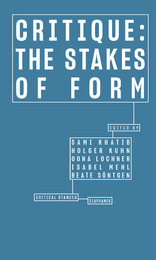
Critique
The Stakes of Form
Edited by Sami Khatib, Holger Kuhn, Oona Lochner, Isabel Mehl, and Beate Söntgen
Diaphanes, 2020
Critique is a form of thinking and acting. Since the end of the 18th century, there has been a dynamization and fluidization of the understanding of form, as concepts such as the break, marginalization, tearing, and opening indicate. As a philosophical problem, the question of form arises in critical theory from Marx to Adorno. Since the 1960s, literary practices have proliferated that generate critical statements less through traditional argument and more through the programmatic use of formal means. At the same time, the writing self, along with its attitudes, reflections, affects, and instruments, visibly enters the critical scene. This volume examines how the interdependence of critique, object, and form translates into critical stances, understood as learnable, reproducible gestures, which bear witness to changing conditions and media of critical practice.
[more]

Crédit et débit
Alexander Kluge and Joseph Vogl
Diaphanes, 2013
Les chaînes privées allemandes ne sont pas vraiment réputées pour le niveau élevé des débats qu’elles diffusent; la surprise est d’autant plus grande pour le zappeur qui, aux alentours de minuit, tombe sur ce genre de phrases : « La superstition économique est un peu comme l’éventail des vertus bourgeoises » ou « Les solutions se trouvent toujours dans la rue, dans le trafic. » Aucun doute : il s’agit d’une des émissions culturelles les plus remarquables – au sens plein du mot – d’Alexander Kluge. Kluge a trouvé en Joseph Vogl un partenaire idéal pour sa technique d’interview si caractéristique. Le résultat de cette passion commune, ce sont plus de 40 interviews télévisuelles qui renouvellent le genre en profondeur. La digression, maniée avec un talent particulier, n’y est jamais gratuite.
[more]
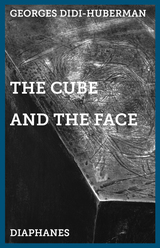
The Cube and the Face
Around a Sculpture by Alberto Giacometti
Georges Didi-Huberman. Edited by Mira Fliescher and Elena Vogman
Diaphanes, 2015
Alberto Giacometti’s 1934 Cube stands apart for many as atypical of the Swiss artist, the only abstract sculptural work in a wide oeuvre that otherwise had as its objective the exploration of reality.
With The Cube and the Face, renowned French art historian and philosopher Georges Didi-Huberman has conducted a careful analysis of Cube, consulting the artist’s sketches, etchings, texts, and other sculptural works in the years just before and after Cube was created. Cube, he finds, is indeed exceptional—a work without clear stylistic kinship to the works that came before or after it. At the same time, Didi-Huberman shows, Cube marks the transition between the artist’s surrealist and realist phases and contains many elements of Giacometti’s aesthetic consciousness, including his interest in dimensionality, the relation of the body to geometry, and the portrait—or what Didi-Huberman terms “abstract anthropomorphism.” Drawing on Freud, Bataille, Leiris, and others Giacometti counted as influence, Didi-Huberman presents fans and collectors of Giacometti’s art with a new approach to transitional work.
With The Cube and the Face, renowned French art historian and philosopher Georges Didi-Huberman has conducted a careful analysis of Cube, consulting the artist’s sketches, etchings, texts, and other sculptural works in the years just before and after Cube was created. Cube, he finds, is indeed exceptional—a work without clear stylistic kinship to the works that came before or after it. At the same time, Didi-Huberman shows, Cube marks the transition between the artist’s surrealist and realist phases and contains many elements of Giacometti’s aesthetic consciousness, including his interest in dimensionality, the relation of the body to geometry, and the portrait—or what Didi-Huberman terms “abstract anthropomorphism.” Drawing on Freud, Bataille, Leiris, and others Giacometti counted as influence, Didi-Huberman presents fans and collectors of Giacometti’s art with a new approach to transitional work.
[more]
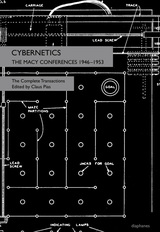
Cybernetics
The Macy Conferences 1946-1953. The Complete Transactions
Edited by Claus Pias
Diaphanes, 2016
Between 1946 and 1953, the Josiah Macy, Jr. Foundation sponsored a series of conferences aiming to bring together a diverse, interdisciplinary community of scholars and researchers who would join forces to lay the groundwork for the new science of cybernetics. These conferences, known as the Macy conferences, constituted a landmark for the field. They were the first to grapple with new terms such as information and feedback and to develop a cohesive and broadly applicable theory of systems that would become equally applicable to living beings and machines, economic and cognitive processes, and many scholarly disciplines. The concepts that emerged from the conferences come to permeate thinking in many fields, including biology, neurology, sociology, ecology, economics, politics, psychoanalysis, linguistics, and computer science.
This book contains the complete transcripts of all ten Macy conferences and the guidelines for the conference proceedings. These transcripts are supplemented with an introduction by Claus Pias that charts the significance of the Macy conferences to the history of science.
This book contains the complete transcripts of all ten Macy conferences and the guidelines for the conference proceedings. These transcripts are supplemented with an introduction by Claus Pias that charts the significance of the Macy conferences to the history of science.
[more]
READERS
Browse our collection.
PUBLISHERS
See BiblioVault's publisher services.
STUDENT SERVICES
Files for college accessibility offices.
UChicago Accessibility Resources
home | accessibility | search | about | contact us
BiblioVault ® 2001 - 2024
The University of Chicago Press









